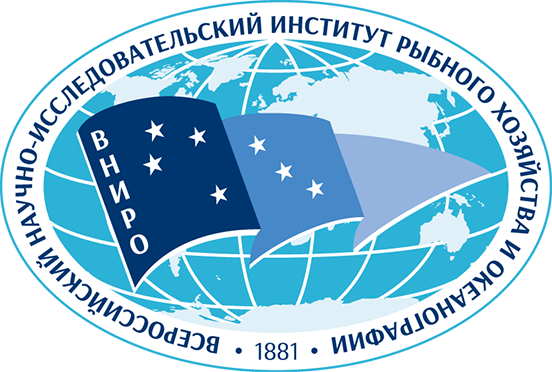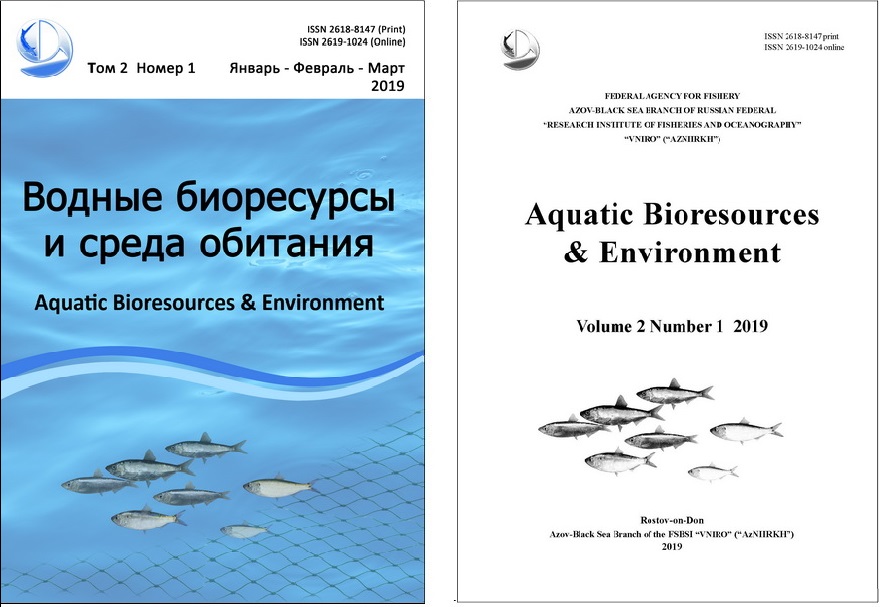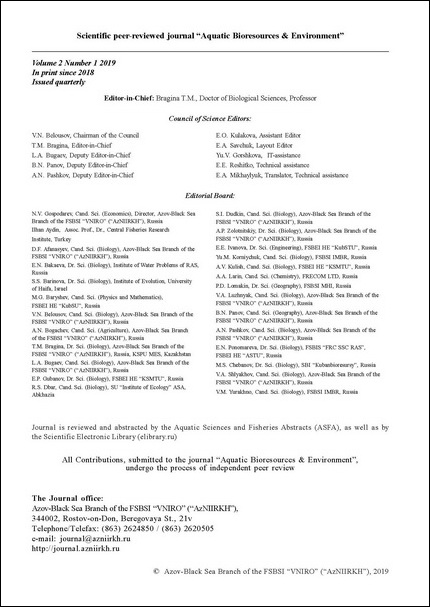Год / Year
2019
Review Articles
Environmental Concerns and the State of the Aquatic Environment
Spatio-temporal features of the nutrients dynamics in the northeastern Black Sea.
Baskakova T.E., Kosenko Yu.V., Burdina E.I.
Abstract. Spatio-temporal dynamics of nutrients in the deep and coastal waters of the Black Sea for the long- term period of 1996–2018 was investigated. The research was carried out in the spring (March–April–May) and summer-autumn (August–September) periods of the year. Samples were collected at a standard depth down to 200 m. It has been shown that in the deep-water area of the Black Sea, seasonal dynamics of nutrients and their distribution extremes are closely related to biological and hydrological processes in the water column. During upwelling phenomena, supplementing of the active layer with mineral nitrogen and phosphorus is obser ved. Accumulation of organic forms of nitrogen- and phosphorus-containing compounds during a photosynthetic process is accompanied by depletion of their mineral constituent. The dynamics of biogenic compounds in the coastal part of the sea are much less susceptible to seasonal variation. The main feature of the vertical distribution of biogenic substances in coastal waters is their highest concentration in the surface layer. Among the dynamic factors in the coastal zone, upwelling is of great importance. Detailed analysis of multi-year data from two periods (1960–1970 and 1996–2018) showed the identity of the vertical distribution of nitrogen and phosphorus concentrations in the deep sea with an increase in the portion of the organic component in the active layer in the modern period in comparison with 1960–1970.
Keywords: Black Sea, biogenic elements, coastal zone, deep-water zone, deep water, phytoplankton.
Pesticidal pollution of artificial reservoirs of the Kuma-Manych Cascade.
Zinchuk O.A., Valiullin V.A., Karpushina Yu.E.
Abstract. In the habitat (water and bottom sediments) of the hydrobionts of the reservoirs of the Kuma-Manych Cascade, the content of 14 active ingredients (AI), the most widely-applied in the agriculture of the region for the modern-class pesticides, which half-life can reach half a year, was studied. In areas with developed agricultural production, the use of plant protection chemicals is an integral part of the cycle. Seeping through the soil or being transferred with air masses, these substances can get into the water and accumulate in the bottom sediments. It has been established that the concentrations of active ingredients (AI) of pesticides in the habitat of hydrobionts of the reservoirs of the Kuma-Manych Cascade are lower than the established maximum permissible concentrations (MAC) by 1–3 orders of magnitude. The method used was high performance liquid chromatography (HPLC). To prepare for chromatography, the extraction of AI pesticides from water and sediment samples was carr ied out using dichloromethane, followed by drying with anhydrous sodium sulfate and purifying the extracts by means of solid phase extraction cartridges (if necessary). AI identification of pesticides was carried out by retention time, whereas quantitative determination required the absolute calibration method. Standard samples of AI pesticides were provided by Bayer company.
Keywords: pesticides, pesticidal pollution, MPC, HPLC, active ingredients.
Biology and Ecology of Aquatic Organisms
Reference values of some indicators of the so-iuy mullet Liza haematocheilus (Temminck & Schlegel, 1845) from the Azov and Black Seas Basin at different stages of reproductive cycle.
Bugaev L.A., Voikina A.V., Ruzhinskaya L.D., Lozhichevskaya T.V.
Abstract. The long-term data on the so-iuy mullet Liza haematocheilus (Temminck & Schlegel, 1845) from the Azov-Black Sea Basin have been analyzed regarding the observation seasons, fish sex and stages of gonad maturity. The following parameters of the fish have been assessed: distribution of oocytes by their diameter, the content of total protein and lipids in muscles, gonads and liver, and cholesterol and lipids in blood serum. When evaluating variation series of large samples of oocytes in the period of protoplasmic growth, median s and percentiles can be calculated and used further as reference values to assess frequency distribution of oocyte diameters of a specific individual. The comparison is carried out by correlating indicators of the reference series with the empirical median of the specimen examined. Extensive empirical material analyzed by resampling has been used to calculate with the help of mathematical modelling the reference points that cover 80–90 % of the sample; these points can be applied as markers when we analyze either separate specimens or the sample in question. It is shown that in the Azov and Black Sea Basin, the so-iuy mullet spawns once a year with the exception of those years that are characterized by a prolonged and cold winter. Under such conditions, a repeated spawning is possible. The content of total protein and lipids was shown to reflect the intensity of adaptation processes that occur in the fish preparing for wintering and spawning. In the females, these processes have a more pronounced amplitude due to the specificities associated with a significant redistribution of plastic resources during gonad maturation.
Keywords: Liza haematocheilus, oocyte diameter, total lipids, total protein, bootstrap, serum protein, serum lipids, serum cholesterol, reproductive cycle, gonad maturity.
Bugaev L.A., Voikina A.V., Ruzhinskaya L.D., Lozhichevskaya T.V.
Abstract. The long-term data on the so-iuy mullet Liza haematocheilus (Temminck & Schlegel, 1845) from the Azov-Black Sea Basin have been analyzed regarding the observation seasons, fish sex and stages of gonad maturity. The following parameters of the fish have been assessed: distribution of oocytes by their diameter, the content of total protein and lipids in muscles, gonads and liver, and cholesterol and lipids in blood serum. When evaluating variation series of large samples of oocytes in the period of protoplasmic growth, median s and percentiles can be calculated and used further as reference values to assess frequency distribution of oocyte diameters of a specific individual. The comparison is carried out by correlating indicators of the reference series with the empirical median of the specimen examined. Extensive empirical material analyzed by resampling has been used to calculate with the help of mathematical modelling the reference points that cover 80–90 % of the sample; these points can be applied as markers when we analyze either separate specimens or the sample in question. It is shown that in the Azov and Black Sea Basin, the so-iuy mullet spawns once a year with the exception of those years that are characterized by a prolonged and cold winter. Under such conditions, a repeated spawning is possible. The content of total protein and lipids was shown to reflect the intensity of adaptation processes that occur in the fish preparing for wintering and spawning. In the females, these processes have a more pronounced amplitude due to the specificities associated with a significant redistribution of plastic resources during gonad maturation.
Keywords: Liza haematocheilus, oocyte diameter, total lipids, total protein, bootstrap, serum protein, serum lipids, serum cholesterol, reproductive cycle, gonad maturity.
Elaboration of the size at first maturity in so-iuy mullet Liza haematocheilus, using advanced capabilities of probit method.
Mikhaylyuk A.N., Solod R.А.
Abstract. The length of so-iuy mullet Liza haematocheilus, at which 50 % of males and females reach maturity, was elaborated and defined more precisely using advanced capabilities of probit method. Such capabilities include constraining probit regression lines for both sexes to be parallel and using individual values of fish length instead of grouped ones. Previously, these capabilities were not applied in the practice of ichthyological r esearch. Elaborated estimations of the standard length, at which 50 % of so-iuy mullet specimens reach maturity, were
36.9 cm and 40.5 for males and females respectively, and confidence limits of these estimations with 95 % confidence probability were 34.3–38.4 cm and 38.9–41.8. The degree, to which the estimation was made more precise as compared to the estimation that had been derived earlier using conventional approach, was noticeable for males and is attributable to constraining probit regression lines to be parallel. This condition gave the opportunity to make up for intrinsic deficiency of data, which lay in the fact that, during calculations, the data on the males of 35.0 cm length and smaller could not be used because, among the individuals of this size, there was a significant number of those, which sex was not differentiated. Use of individual values for length instead of grouped ones did not result in significant increase in accuracy of estimations.
Keywords: so-iuy mullet, Liza haematocheilus, sexual maturity, Azov Sea.
Decapods (Decapoda Latrelle, 1802) of the Kerch Strait (Azov Sea) area: a retrospective study and modern composition.
Kulish A.V., Levintsova D.M.
Abstract. Current taxonomic composition of the decapods of the Kerch Strait was investigated. Relevance of the study is emphasized by the fact that the Kerch Strait is an ecological corridor connecting the Azov and Black Seas, which are water basins with contrasting hydrographic, hydrological, physical, and chemical environmental conditions. The data, collected during the field studies carried out during 2014–2018, as well as th e data of an extensive retrospective literary review, are used as the research material. The annotated and taxonomic check lists of the modern fauna of decapods from the Kerch Strait area that include 25 species belonging to 20 genera from 17 families and 5 infra-orders are given. Eight species (Palaemon macrodactylus, Hippolyte sapphica, Philocheras fasciatus, Philocheras trispinosus, Pisidia longimana, Eriphia verrucosa, Liocarcinus vernalis, Xantho poressa) are recorded as a part of the Kerch Strait fauna for the first time. Based on the data on spatial distribution of the decapods in the Kerch Strait, three main regions were identified: the Northern Azov Sea (I), the limans of the Taman group (II), and the Southern Black Sea (III). Lists of decapods for each area are presented.
The greatest taxonomic and species richness is recorded for region III (25 species), and the lowest one — for region I (8 species).
Keywords: Decapoda, Palaemon macrodactylus, Azov Sea, Kerch Strait, species diversity, taxonomic structure
Aquaculture and Methods of Artificial Reproduction
Analysis of some economic aspects of the mollusc farms creation in the Black Sea.
Kryuchkov V.G.
Abstract. Currently, the Russian Federation strongly supports the investors, ready to direct their capital investments to marine farms for mussel and oyster cultivation in the Black Sea. For these investors, one of the most vital challenges to address is the evaluation of their investment size. The size of prospective investments was determined, primarily, by the level of material and technical basis of investments, planned for realization, and by the size of necessary operational expenditures. With the experience of existing farms being taken into account, tentative financial budget, necessary for creation of a standard farm for mollusc culture in the Black Sea, with no bounds to a specific area, is presented, set as low as it is practicable. The activity stages are proposed for each year; the size of capital expenditures on the main elements of a constructed farm and its prospective term for achieving profitability are identified. With regard to the allotment of allowable area (up to 300 ha) and respective volumes of mollusc cultivation, it has been estimated that the size of capital investments can amount to no less than 30.0 million (RUR). It is shown that one of the components of the farm successful operation is competent product marketing. Recommendations on increasing the efficiency of its operation by means of constructing a mussel processing workshop, allowing for output of food products with a longer storage life, as well as ar ranging for cultivation of more expensive oysters, are given.
Keywords: mussels, conchioculture, farm, investments, capital costs, prime cost, commercial output, prospects
Growth dynamics of copepods (suborder Calanoida) populations in basins and ponds at different temperatures of culture medium from the Kerch Strait waters.
Novoselova N.V., Turkulova V.N.
Abstract. Copepods density dynamics at different temperatures of culture medium was studied. Cultivation of copepods was carried out using formula feeds, based on organic and inorganic fertilizers, micronutrients and vitamins. Based on the population state, volume of the introduced formula feed was calculated. For the culture purposes fiberglass vats and ground-excavated ponds were used. The sea water from the Kerch Strait served as culture medium. The data sample on the temperature of culture medium was taken for the same number of cultivation days (48–56). Data on density dynamics of copepods in vats and ponds at different temper atures of culture medium are given. Results were obtained in the process of mass cultivation of copepods as live feed for marine fish larvae. During their cultivation, a food factor (their feeding) served as the main indicator of changes in density of copepods in the context of their cultivation at any temperature of aquatic medium. Another important indicator, giving evidence of the density increase, was represented by the factor of the culture environmental conditions, which are highly specific for each species. Under the same temperature range, copepods increase their density in ponds more rapidly than in tanks. Studying the copepods density dynamics at different temperatures of culture medium has shown that the increase in copepod density occurs even under suboptimal temperature of culture medium (12–19 °С), as well as under optimal temperature regime (20–24 °С).
Keywords: Calanoida, copepods, culture, culture media, temperature, trophic factor.
Informational Messages
To the 65th Anniversary of a prominent oceanologist, Candidate of Geographical Sciences, Associate Professor Raisa Borovskaya.
Shlyakhov V.A.
Abstract. On the 6th of February, 2019, Raisa Vasilyevna Borovskaya celebrated her 65th Anniversary. She dedicated most part of her life to the work in the Southern Scientific Research Institute of Fisheries and Oceanography (YugNIRO) (since December 2016 — Kerch Branch (“YugNIRO”) of the FSBSI “AzNIIRKH”, since 2019 — the Azov-Black Sea Branch of the FSBSI “VNIRO” (“AzNIIRKH”). Raisa Borovskaya began her work as an engineer-oceanologist. It was her who devised the concept of applying remote sensing of marine surface to the fisheries needs. On the basis of satellite and conventional oceanographic contact observations, she studied such phenomena as upwelling and currents, ice formation, transformation and drift, hypoxia in the near bottom layer and fish kill events. She is also engaged in assessment of the influence of abiotic environmental factors on fishing performance in some areas of the Azov and Black Sea Basin. Total number of her published works is about 70, out of which two are monographies and one is the Candidate's Thesis “Results of oceanographic and fisheries research of the Black Sea and the Sea of Azov on the basis of satellite information”. In addition to her research activity, Raisa Borovskaya is involved in teaching at the departments “Aquatic Bioresources and Mariculture” and “Marine Ecology” of the FSBEI HE “Kerch State Maritime Technological University”.
Keywords: Borovskaya R.V., satellite monitoring, fisheries oceanography, abiotic environmental factors.




